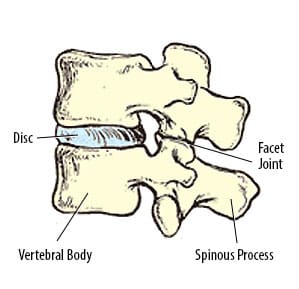Low Back Pain is an extremely common condition affecting 4 out of 5 people at some point in their adult life. The natural aging process of the spine leads to degeneration of the spinal integrity. In severe cases this leads to debilitating pain and discomfort. An understanding of pain generators is easier with a brief understanding of the spinal anatomy.

Your spine is composed of 24 bones called vertebrae. These are divided into 3 sections: cervical (neck), thoracic (mid back), and lumbar (lower back). The base of the spine is a section known as the sacral region. Between each bone is soft tissue known as the disc. The disc acts as a shock absorber for the bones allowing the spine to bend and move. Encased by your vertebrae are your spinal cord and nerve roots. Along the back of your spine under the surface of your skin are small bony protuberances called spinous processes.
One specific condition resulting from deterioration of the spine is called spinal stenosis. This results in the nerves around the spine becoming pinched. This leads to symptoms which can include low back pain, shooting or burning pain in the legs, weakness in the legs or feet, numbness and tingling in the legs and decreased range of motion.
In certain cases the symptoms of stenosis persist despite conservative treatment with medications, physical therapy, activity modification, and steroid injections. At this point surgical options may be recommended. Generally, surgery would consist of fusion and/or decompression. During this procedure, spinal vertebrae are fused together, usually with the aid of implanted hardware, to restrict motion in the spine and decrease pain. In a traditional fusion, larger incisions are made resulting in more muscle disruption, blood loss and longer postoperative recovery. A simpler alternative may be available in the form of a minimally invasive interspinous decompression system.
For patients who are specifically interested in a “smaller surgery,” or elderly patients who would not be a candidate for a more complex surgery with longer anesthesia time, this may be an alternative. The interspinous device is typically a small titanium implant that attaches between the spinous process. The disc remains in place and decompression occurs from the additional space created by the interspinous implant. This leads to less pain and quicker recovery.
The typical presentation of a patient that is an ideal candidate is one complaining of back AND buttock or leg pain. The pain is generally worse standing and walking. A necessary component of the pain is that it is adequately relieved if the patient sits down or leans forward. An example is the patient that has to rest forward on the shopping cart while walking in a grocery store.
If you are experiencing any of the above symptoms, a formal evaluation and adequate testing can be performed to assess your condition. Different options from conservative measures to surgical options can be discussed and implemented based on your comfort level. We would love to help you GET BACK TO LIFE!